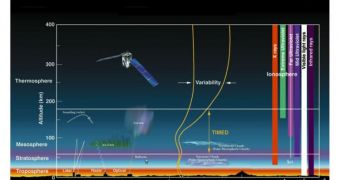Officials at NASA announce that they have decided to prolonged the Thermosphere Ionosphere Mesosphere Energetics and Dynamics (TIMED) mission for the fourth time, after an exquisite, nine-year-long run thus far.
The satellite's main mission has always been to analyze the boundary between Earth and outer space. It is conducting investigations of the upper atmosphere, studying the interactions that occur at this level.
Thus far, it has collected more data on this than any other similar mission launched anywhere in the world before and after it. The spacecraft was launched from the Vandenberg Air Force Base in California on December 7, 2001, aboard a Delta II delivery system.
The mission covered an important gap in our knowledge of the planet's atmosphere, experts say, as it targeted the mesosphere and the lower thermosphere/ionosphere, which had been largely left unstudied before it launched.
The enormous services that the mission brought to understanding this layer of the atmosphere have earned it three mission extensions thus far, the last of which ended on October 1, 2010.
NASA decided to extend its operational life once more, this time until 2014. One of the main reason why the decision was taken is because TIMED can tell us more about how the Sun and human activities are influencing this critical layer of the atmosphere.
“The middle part of the atmosphere was the part we kind of ignored. It’s too high for balloons and too low for spacecraft,” says TIMED deputy project scientist John Sigwarth.
“So the understanding of this middle atmosphere and its impact on the upper atmosphere has been tremendously increased due to TIMED,” adds the expert, who holds an appointment at the Greenbelt, Maryland-based NASA Goddard Space Flight Center (GSFC).
During this fourth mission extension, the satellite's primary objective will be to discover traits that separate the influence of humans from that of naturally-occurring phenomena in this region.
“The Sun is a variable star with an 11 year cycle. So, if things change in the mesosphere, you don’t know if it’s because the Sun changed or because human activity has caused the change,” the expert adds.
“By getting back to the same point in the cycle, we can compare what it was like then, and what it’s like now, and see if there’s a long term trend of changes that’s not solar related,” Sigwarth explains.
TIMED features four main scientific instruments, called GUVI, SEE, TIDI and SABER, Science Blog reports.
GUVI is the Global Ultraviolet Imager, SEE stands for the Solar Extreme Ultraviolet Experiment, TIDI is an acronym for the TIMED Doppler Interferometer, and SABER is the name of the Sounding of the Atmosphere using Broadband Emission Radiometry instrument.

 14 DAY TRIAL //
14 DAY TRIAL //